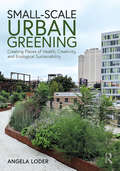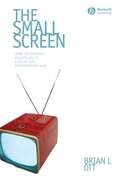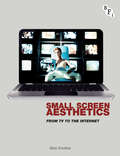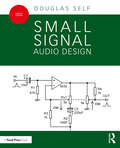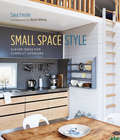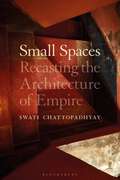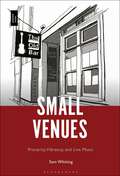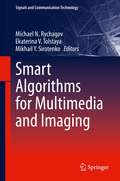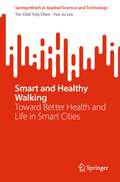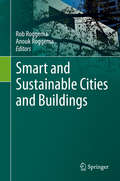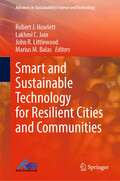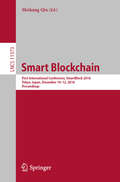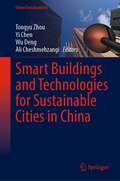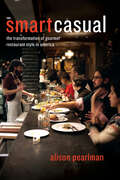- Table View
- List View
Small-Scale Public Transportable and Pre-Fabricated Buildings: Evaluating their Functional Performance (Routledge Research in Architecture)
by Junjie XiThis book investigates the design, operation and use of contemporary transportable buildings, and explores how functional performance can be assessed in small-scale examples for public use alongside their relationship to other design elements. The research focuses on three case studies, Chengdu Hualin Elementary School, Exxopolis and Kreod, that do not require a high-technology building environment or complex construction skills. Transportable buildings are defined as those that are transported in a number of parts for assembly on site. Contemporary transportable buildings respond to ecological issues, social impacts, technological innovation and economic demands. They can be used to measure a society’s development in environmental sustainability, innovation and economic growth through various forms. Small-scale transportable buildings fulfil many temporary habitation needs in diverse roles, such as non-emergency transitional housing, ephemeral exhibition buildings and seasonal entertainment facilities. Small-Scale Public Transportable and Pre-Fabricated Buildings will be a useful research text for academics and students in architecture, design and sustainable building performance.
Small-Scale Public Transportable and Pre-Fabricated Buildings: Evaluating their Functional Performance (Routledge Research in Architecture)
by Junjie XiThis book investigates the design, operation and use of contemporary transportable buildings, and explores how functional performance can be assessed in small-scale examples for public use alongside their relationship to other design elements. The research focuses on three case studies, Chengdu Hualin Elementary School, Exxopolis and Kreod, that do not require a high-technology building environment or complex construction skills. Transportable buildings are defined as those that are transported in a number of parts for assembly on site. Contemporary transportable buildings respond to ecological issues, social impacts, technological innovation and economic demands. They can be used to measure a society’s development in environmental sustainability, innovation and economic growth through various forms. Small-scale transportable buildings fulfil many temporary habitation needs in diverse roles, such as non-emergency transitional housing, ephemeral exhibition buildings and seasonal entertainment facilities. Small-Scale Public Transportable and Pre-Fabricated Buildings will be a useful research text for academics and students in architecture, design and sustainable building performance.
Small-Scale Urban Greening: Creating Places of Health, Creativity, and Ecological Sustainability
by Angela LoderSmall-scale urban greening projects are changing the urban landscape, shifting our experience and understanding of greenspaces in our cities. This book argues that including power dynamics, symbolism, and aesthetics in our understanding of the human relationship to urban nature can help us create places that nurture ecological and human health and promote successful and equitable urban communities. Using an interdisciplinary approach to current research debates and new comparative case studies on community perceptions of these urban greening projects and policies, this book explores how small-scale urban greening projects can impact our sense of place, health, creativity, and concentration while also being part of a successful urban greening program. Arguing that wildness, emotion, and sense of place are key components of our human–nature relationship, this book will be of interest to designers, academics, and policy makers.
Small-Scale Urban Greening: Creating Places of Health, Creativity, and Ecological Sustainability
by Angela LoderSmall-scale urban greening projects are changing the urban landscape, shifting our experience and understanding of greenspaces in our cities. This book argues that including power dynamics, symbolism, and aesthetics in our understanding of the human relationship to urban nature can help us create places that nurture ecological and human health and promote successful and equitable urban communities. Using an interdisciplinary approach to current research debates and new comparative case studies on community perceptions of these urban greening projects and policies, this book explores how small-scale urban greening projects can impact our sense of place, health, creativity, and concentration while also being part of a successful urban greening program. Arguing that wildness, emotion, and sense of place are key components of our human–nature relationship, this book will be of interest to designers, academics, and policy makers.
The Small Screen: How Television Equips Us to Live in the Information Age
by Brian L. OttTelevision is one of the most important socializing forces in contemporary culture. This book is a cultural history of prime-time television in America during the 1990s. Examines changes that took place in programming, such as the rapid adoption of cable, the proliferation of content providers, the development of niche marketing, the introduction of high-definition television, the blurring of traditional genres, and the creation of new formats like reality-based programming Argues that television programmes of the 1990s afforded viewers a symbolic resource for negotiating the psychological challenges associated with the shift from the Industrial Age to the Information Age Explores the ways in which television provided viewers with tools for coming to terms with their fears about living in the fast-paced , increasingly diverse, information-laden society of the 90s
Small Screen Aesthetics: From Television to the Internet
by NA NAThis new study provides an introduction to TV aesthetics and viewership from the 1940s to the present day, at a time when television as a medium is 'converging' with the pc and laptop.
Small Signal Audio Design
by Douglas SelfSmall Signal Audio Design is a highly practical handbook providing an extensive repertoire of circuits that can be assembled to make almost any type of audio system. This fully revised fourth edition offers wholly new content on internally balanced audio design, electret microphones, emitter-follower stability, microphony in capacitors, and much, much more. This book continues the engaging prose style familiar to readers as you learn why mercury-filled cables are not a good idea, the pitfalls of plating gold on copper, and what quotes from Star Trek have to do with PCB design. Learn how to: make amplifiers with apparently impossibly low noise design discrete circuitry that can handle enormous signals with vanishingly low distortion transform the performance of low-cost opamps build active filters with very low noise and distortion while saving money on expensive capacitors make incredibly accurate volume controls make a huge variety of audio equalisers use load synthesis to make magnetic cartridge preamplifiers that have noise so low it is limited by basic physics sum, switch, clip, compress, and route audio signals build simple but ultra-low noise power supplies be confident that phase perception is not an issue. Including all the crucial theories, but with minimal mathematics, Small Signal Audio Design is the must-have companion for anyone studying, researching, or working in audio engineering and audio electronics.
Small Signal Audio Design
by Douglas SelfSmall Signal Audio Design is a highly practical handbook providing an extensive repertoire of circuits that can be assembled to make almost any type of audio system. This fully revised fourth edition offers wholly new content on internally balanced audio design, electret microphones, emitter-follower stability, microphony in capacitors, and much, much more. This book continues the engaging prose style familiar to readers as you learn why mercury-filled cables are not a good idea, the pitfalls of plating gold on copper, and what quotes from Star Trek have to do with PCB design. Learn how to: make amplifiers with apparently impossibly low noise design discrete circuitry that can handle enormous signals with vanishingly low distortion transform the performance of low-cost opamps build active filters with very low noise and distortion while saving money on expensive capacitors make incredibly accurate volume controls make a huge variety of audio equalisers use load synthesis to make magnetic cartridge preamplifiers that have noise so low it is limited by basic physics sum, switch, clip, compress, and route audio signals build simple but ultra-low noise power supplies be confident that phase perception is not an issue. Including all the crucial theories, but with minimal mathematics, Small Signal Audio Design is the must-have companion for anyone studying, researching, or working in audio engineering and audio electronics.
Small Space Style: Clever Ideas For Compact Interiors
by Sara EmslieThese days, space is a precious commodity. Small Space Style is an inspiring guide to making the most of even the tiniest home.
Small Spaces: Recasting the Architecture of Empire
by Professor Swati ChattopadhyaySmall Spaces recasts the history of the British empire by focusing on the small spaces that made the empire possible. It takes as its subject a series of small architectural spaces, objects, and landscapes and uses them to narrate the untold stories of the marginalized people-the servants, women, children, subalterns, and racialized minorities-who held up the infrastructure of empire. In so doing it opens up an important new approach to architectural history: an invitation to shift our attention from the large to the small scale. Taking the British empire in India as its primary focus, this book presents eighteen short, readable chapters to explore an array of overlooked places and spaces. From cook rooms and slave quarters to outhouses, go-downs, and medicine cupboards, each chapter reveals how and why these kinds of minor spaces are so important to understanding colonialism. With the focus of history so often on the large scale - global trade networks, vast regions, and architectures of power and domination - Small Spaces shows instead how we need to rethink this aura of magnitude so that our reading is not beholden such imperialist optics. With chapters which can be read separately as individual accounts of objects, spaces, and buildings, and introductions showing how this critical methodology can challenge the methods and theories of urban and architectural history, Small Spaces is a must-read for anyone wishing to decolonize disciplinary practices in the field of architectural, urban, and colonial history. Altogether, it provides a paradigm-breaking account of how to 'unlearn empire', whether in British India or elsewhere.
Small Spaces: Recasting the Architecture of Empire
by Professor Swati ChattopadhyaySmall Spaces recasts the history of the British empire by focusing on the small spaces that made the empire possible. It takes as its subject a series of small architectural spaces, objects, and landscapes and uses them to narrate the untold stories of the marginalized people-the servants, women, children, subalterns, and racialized minorities-who held up the infrastructure of empire. In so doing it opens up an important new approach to architectural history: an invitation to shift our attention from the large to the small scale. Taking the British empire in India as its primary focus, this book presents eighteen short, readable chapters to explore an array of overlooked places and spaces. From cook rooms and slave quarters to outhouses, go-downs, and medicine cupboards, each chapter reveals how and why these kinds of minor spaces are so important to understanding colonialism. With the focus of history so often on the large scale - global trade networks, vast regions, and architectures of power and domination - Small Spaces shows instead how we need to rethink this aura of magnitude so that our reading is not beholden such imperialist optics. With chapters which can be read separately as individual accounts of objects, spaces, and buildings, and introductions showing how this critical methodology can challenge the methods and theories of urban and architectural history, Small Spaces is a must-read for anyone wishing to decolonize disciplinary practices in the field of architectural, urban, and colonial history. Altogether, it provides a paradigm-breaking account of how to 'unlearn empire', whether in British India or elsewhere.
A Small Town Love Story: Colonial Beach, Virginia (Mira Ser.)
by Sherryl WoodsThe text in this ebook is fixed to preserve the layout of the book and it is not possible to enlarge the font size. It may be unsuitable for eink readers and mobile phones and we recommend you download a sample to your device before purchase.
Small Venues: Precarity, Vibrancy and Live Music
by Sam WhitingThroughout the history of popular music, the careers of many culturally significant artists and groups began on the small stages of local bars clubs, pubs, and discotheques. When the stories of The Beatles, Jimi Hendrix, and the New York punk hardcore and post punk scenes are told, iconic venues such as The Cavern, The Marquee and CBGB's serve as the settings of their early chapters Small live music venues such as these are pivotal in the narratives and history of popular music. However, very few of them survive. This book focusses on the role of small live music venues as incubators for emerging talent and social hubs for music scene participants. Such venues are grassroots spaces of cultural labor and production that often struggle with issues of financial precarity yet are fundamental to the live music ecology of a city, acting both as platforms for emergent performers and spaces of sociality for local music scenes.
Small Venues: Precarity, Vibrancy and Live Music
by Sam WhitingThroughout the history of popular music, the careers of many culturally significant artists and groups began on the small stages of local bars clubs, pubs, and discotheques. When the stories of The Beatles, Jimi Hendrix, and the New York punk hardcore and post punk scenes are told, iconic venues such as The Cavern, The Marquee and CBGB's serve as the settings of their early chapters Small live music venues such as these are pivotal in the narratives and history of popular music. However, very few of them survive. This book focusses on the role of small live music venues as incubators for emerging talent and social hubs for music scene participants. Such venues are grassroots spaces of cultural labor and production that often struggle with issues of financial precarity yet are fundamental to the live music ecology of a city, acting both as platforms for emergent performers and spaces of sociality for local music scenes.
Smaller Houses of the 1920s: 55 Examples
by Ethel B. PowerFrom a peak era in American domestic architecture comes this survey of homes from across the country. Its wealth of styles features both new American designs and traditional European-inspired buildings of wood, stucco, concrete, brick, and stone. The 130 captioned black-and-white illustrations and 55 floor plans offer external and internal views for a full perspective on the houses' architectural ingenuity and originality. <p><p> One of the most striking features of these homes is their extreme variety in terms of efficient design. The plans combine a limited number of units into a workable whole, without sacrifice of convenience or economy. Blending practicality and charm, these imaginative designs will inspire professional architects, amateur builders, and anyone interested in the ways American architects adapted Old World designs and added elements of native style to produce a new and vibrant home building idiom.
Smart Algorithms for Multimedia and Imaging (Signals and Communication Technology)
by Michael N. Rychagov Ekaterina V. Tolstaya Mikhail Y. SirotenkoThis book presents prospective, industrially proven methods and software solutions for storing, processing, and viewing multimedia content on digital cameras, camcorders, TV, and mobile devices. Most of the algorithms described here are implemented as systems on chip firmware or as software products and have low computational complexity and memory consumption. In the four parts of the book, which contains a total of 16 chapters, the authors address solutions for the conversion of images and videos by super-resolution, depth estimation and control and mono-to-stereo (2D to 3D) conversion; display applications by video editing; the real-time detection of sport episodes; and the generation and reproduction of natural effects. The practical principles of machine learning are illustrated using technologies such as image classification as a service, mobile user profiling, and automatic view planning with dictionary-based compressed sensing in magnetic resonance imaging. The implementation of these technologies in mobile devices is discussed in relation to algorithms using a depth camera based on a colour-coded aperture, the animated graphical abstract of an image, a motion photo, and approaches and methods for iris recognition on mobile platforms. The book reflects the authors’ practical experience in the development of algorithms for industrial R&D and the commercialization of technologies.Explains digital techniques for digital cameras, camcorders, TV, mobile devices;Offers essential algorithms for the processing pipeline in multimedia devices and accompanying software tools;Features advanced topics on data processing, addressing current technology challenges.
Smart and Healthy Walking: Toward Better Health and Life in Smart Cities (SpringerBriefs in Applied Sciences and Technology)
by Tin-Chih Toly Chen Yun-Ju LeeThis book examines smart technologies and their invaluable role in augmenting the walking experience of mobile users. From meticulously planned walking routes to precise footprint detection and analysis, as well as cutting-edge fall detection and prevention mechanisms, these intelligent technologies have the potential to revolutionize healthy and smart walking. Against the backdrop of the post-COVID-19 era, where unrestricted mobility has become pivotal for restoring normalcy, the demand for smart healthcare solutions has soared. The book explores latest advances in sensor technology, cloud computing, deep learning, and networking and related innovative applications that can leverage smart technologies to enhance healthy walking.
Smart and Sustainable Cities and Buildings (Contemporary Urban Design Thinking Ser.)
by Rob Roggema Anouk RoggemaThis book brings together the papers presented at the Smart and Sustainable Built Environments Conference, 2018 (SASBE).This latest research falls into two tracks: smart and sustainable design and planning cities; and the technicalities of smart and sustainable buildings. The growth of smart cities is evident, but not always linked to sustainability. This book gives an overview of the latest academic developments in increasing the smartness and sustainability of our cities and buildings. Aspects such as inclusivity, smart cities, place and space, the resilient city, urbanity and urban ecology are prominently featured in the design and planning part of the book; while energy, educational buildings, comfort, building design, construction and performance form the sub-themes of the technical part of the book. This book will appeal to urban designers, architects, urban planners, smart city designers and sustainable building experts.
Smart and Sustainable Technology for Resilient Cities and Communities (Advances in Sustainability Science and Technology)
by Lakhmi C. Jain Robert J. Howlett John R. Littlewood Marius M. BalasThis book is a collection of extended versions of papers presented at the KES Covid-19 Challenge international summit. The book focusses on technological, economic, and social developments to combat the effects of global and local disasters as well as the ways in which the recovery from Covid can be used to build more resilient and sustainable communities, industry, and improve the environment. It also discusses the global challenges of human-influenced climate change. There are chapters on making cities and communities more resilient through energy self-sufficiency, food production, resilient housing and buildings, human health and intelligent systems e.g. for forecasting and prediction.
Smart Architecture – A Sustainable Approach for Transparent Building Components Design
by Valentina FrighiThis book explores the specific role that glazing technologies play within the world of smart architecture as important components of contemporary and future sustainable architectural and technological research. Smart Architecture begins with a definition of the concept of “smart” in architecture and examines how innovative technologies and materials have shaped buildings over the years. The author then provides a supporting database of contemporary smart architecture—mapping adopted strategies, recognizing common patterns, and evaluating current and future trends in the context of smart building envelopes, energy efficiency, and the development of high-potential innovative building components. The book proceeds with a focus on the specific role that glazing technologies play in this framework and provides a systematic methodology to quantify options for the effective integration of transparent building components within advanced and innovative building envelope systems.
Smart Blockchain: First International Conference, SmartBlock 2018, Tokyo, Japan, December 10–12, 2018, Proceedings (Lecture Notes in Computer Science #11373)
by Meikang QiuThis book constitutes the refereed proceedings of the First International Conference on Smart Blockchain, SmartBlock 2018, held in Tokyo, Japan, in December 2018. The 17 papers presented in this volume were carefully reviewed and selected from 102 submissions. They focus on a broad range of topics in the area of blockchain, from privacy-preserving solutions to designing advanced blockchain mechanism, from empirical studies to practical manuals.
Smart Buildings: Technology and the Design of the Built Environment
by Ron BakkerHow is technology shaping our built environment and changing the practice of architecture? This book explores how buildings and spaces are designed, built, used, and better understood through technology. A practical guide to technical advances including Internet of Things (IoT), 3D printing, innovative materials and robotics, Smart Buildings also outlines the opportunities for architecture including improved communication, flexibility, wellbeing, productivity and data collection. Bringing together multidisciplinary contributions and case studies from across the globe, this book provides an inspiring practical guide on how technology can inspire new architectural ideas, improving quality, comfort, health and wellbeing in the built environment
Smart Buildings: Technology and the Design of the Built Environment
by Ron BakkerHow is technology shaping our built environment and changing the practice of architecture? This book explores how buildings and spaces are designed, built, used, and better understood through technology. A practical guide to technical advances including Internet of Things (IoT), 3D printing, innovative materials and robotics, Smart Buildings also outlines the opportunities for architecture including improved communication, flexibility, wellbeing, productivity and data collection. Bringing together multidisciplinary contributions and case studies from across the globe, this book provides an inspiring practical guide on how technology can inspire new architectural ideas, improving quality, comfort, health and wellbeing in the built environment
Smart Buildings and Technologies for Sustainable Cities in China (Urban Sustainability)
by Tongyu Zhou Yi Chen Wu Deng Ali CheshmehzangiThis book brings together the insights from professional associations who involved in developing relevant national standards in China, domestic and international scholars who are dedicated to research in related fields, and industry practitioners who have the most hands-on experience. Synthesizing their perspectives, this book discusses the advanced technologies that can meet the requirements for energy efficiency, building performance monitoring and management, and user-centric building services, which are considered the essential components for achieving sustainable and smart cities. Moreover, it provides reflections on the implementation of smart technologies and strategies in practice.
Smart Casual: The Transformation of Gourmet Restaurant Style in America
by Alison PearlmanFine dining and the accolades of Michelin stars once meant chandeliers, white tablecloths, and suited waiters with elegant accents. The stuffy attitude and often scant portions were the punchlines of sitcom jokes—it was unthinkable that a gourmet chef would stoop to plate a burger or a taco in his kitchen. And yet today many of us will queue up for a seat at a loud, crowded noodle bar or eagerly seek out that farm-to-table restaurant where not only the burgers and fries are organic but the ketchup is homemade—but it’s not just us: the critics will be there too, ready to award distinction. Haute has blurred with homey cuisine in the last few decades, but how did this radical change happen, and what does it say about current attitudes toward taste? Here with the answers is food writer Alison Pearlman. In Smart Casual: The Transformation of Gourmet Restaurant Style in America, Pearlman investigates what she identifies as the increasing informality in the design of contemporary American restaurants. By design, Pearlman does not just mean architecture. Her argument is more expansive—she is as interested in the style and presentation of food, the business plan, and the marketing of chefs as she is in the restaurant’s floor plan or menu design. Pearlman takes us hungrily inside the kitchens and dining rooms of restaurants coast to coast—from David Chang’s Momofuku noodle bar in New York to the seasonal, French-inspired cuisine of Alice Waters and Thomas Keller in California to the deconstructed comfort food of Homaro Cantu’s Moto in Chicago—to explore the different forms and flavors this casualization is taking. Smart Casual examines the assumed correlation between taste and social status, and argues that recent upsets to these distinctions have given rise to a new idea of sophistication, one that champions the omnivorous. The boundaries between high and low have been made flexible due to our desire to eat everything, try everything, and do so in a convivial setting. Through lively on-the-scene observation and interviews with major players and chefs, Smart Casual will transport readers to restaurants around the country to learn the secrets to their success and popularity. It is certain to give foodies and restaurant-goers something delectable to chew on.

